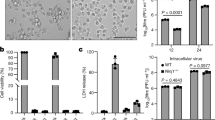Summary.
The effect of a variety of cell death-inducing reagents on the release of herpes simplex virus type 1 (HSV-1) was examined. Ionomycin was found to increase the release of HSV-1, whereas no significant increase was observed by the treatment with TNF-α, anti-Fas antibody, C2-ceramide, sphingosine, H-7, tyrphostin and camptothecin. Ionomycin induced an immediate early peak and a subsequent long-lasting elevation of intracellular Ca2+ concentration ([Ca2+]i). In the absence of extracellular Ca2+, ionomycin neither elevated [Ca2+]i nor increased the release of HSV-1 from the infected cells, indicating that Ca2+ influx play an important role in the release of HSV-1. Studies with trypan blue and annexin V staining revealed that the ionomycin-induced alteration of [Ca2+]i was accompanied by cell death of the infected cells. Disintegration of cell membrane, cytoplasmic vacuole formation and the leakage of virus particles from the cell surface were observed by electron microscopy. These results indicate that Ca2+-dependent cell death showing necrotic alteration is responsible for the enhanced release of HSV-1. The data also give some initial insights into the functional importance of cell death during the late stages of HSV-1 infection.
Similar content being viewed by others
Author information
Authors and Affiliations
Additional information
Received August 5, 2002; accepted September 18, 2002
Rights and permissions
About this article
Cite this article
Yura, Y., Matsumoto, R., Sumi, T. et al. Effect of Ca2+-dependent cell death on the release of herpes simplex virus. Arch Virol 148, 221–235 (2003). https://doi.org/10.1007/s00705-002-0924-1
Issue Date:
DOI: https://doi.org/10.1007/s00705-002-0924-1




